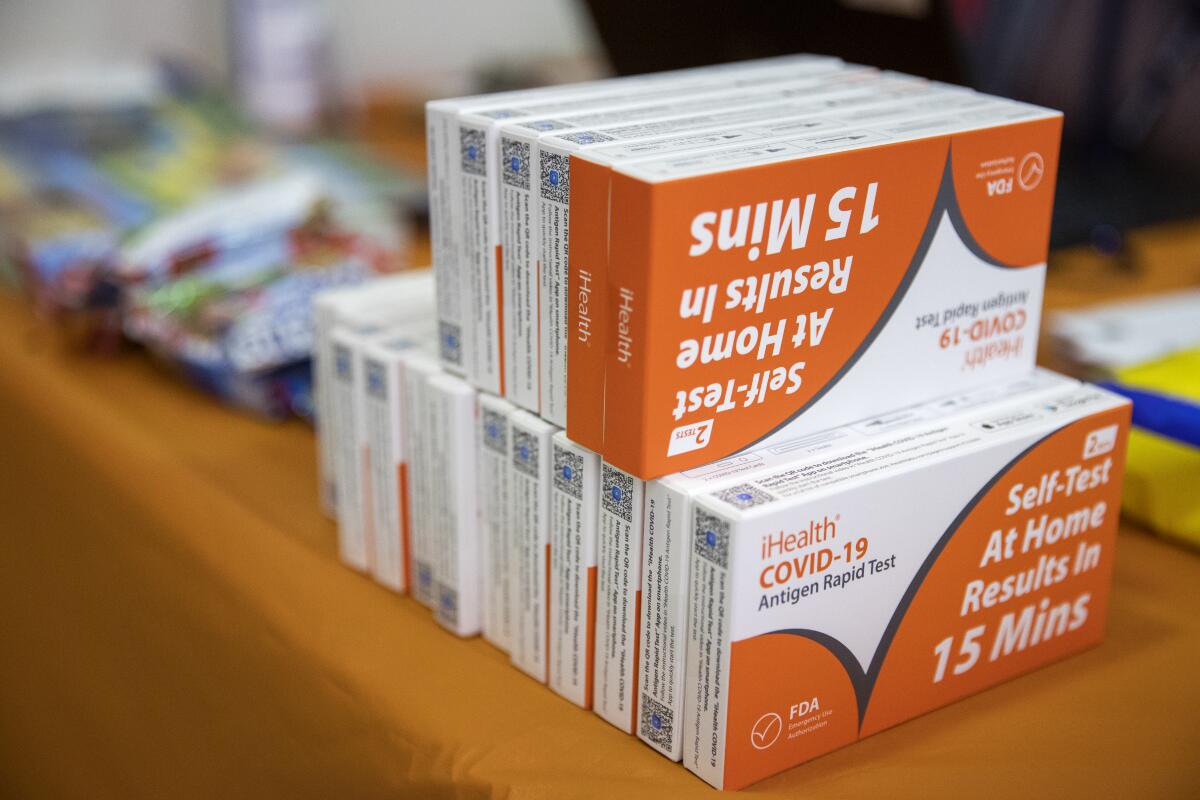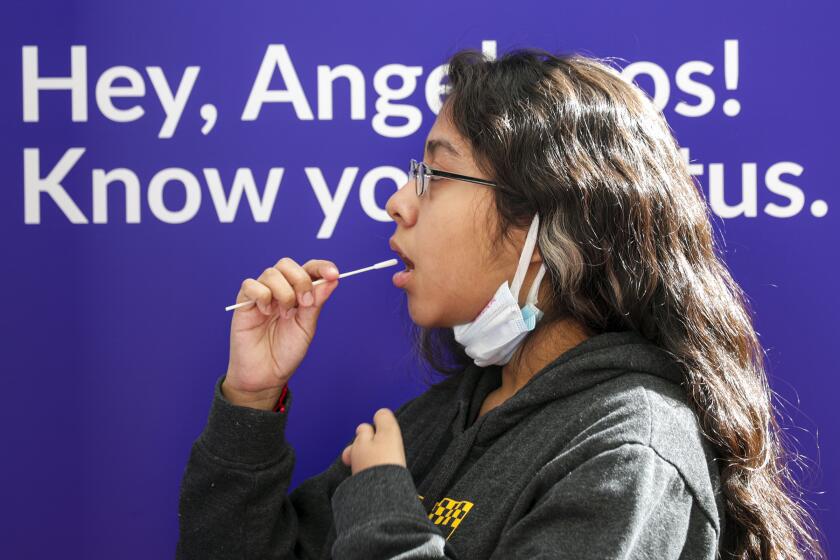You just tested yourself for COVID-19. Should you report the results to L.A. County?

- Share via
The latest surge in COVID-19 infections in California may surpass last winter’s tidal wave, health officials say. And judging by wastewater tests, infections may be even more widespread than the official numbers indicate.
One reason is that some people’s symptoms are so mild that they don’t seek treatment or even get tested. But another significant factor may be the large number of people using at-home tests and not reporting the results.
“Home testing leads to marked underestimates of case numbers,” Dr. Robert Wachter, chair of UC San Francisco’s Department of Medicine, said in an email. “Clearly many hundreds of thousands of people are now diagnosing themselves with positive home tests (generally plus symptoms), and these are not reported.”
Some test kits advise you to call your healthcare provider. Others want you to use the test maker’s app.
The problem, though, is that the healthcare system frowns on user-generated test results — local health officials prioritize quality over quantity when it comes to data. In Los Angeles County and many other jurisdictions, there is no way for people to report the results from store-bought home tests.
“COVID-19 surveillance continues to be based on results from laboratory testing,” not self-tests, the Centers for Disease Control and Prevention says on its website. Although data about new cases help public health agencies as they try to slow the spread of COVID, “the public health community, including CDC, is confident that situational awareness remains strong without receiving self-test results.”
So what should you do after you take a test? If it comes back positive, health officials say, you should isolate at home, alert the people with whom you’ve been in close contact and tell your healthcare provider. The L.A. County Department of Public Health has a hotline for you to call — (833) 540-0473 — if you have questions, need referrals or need help in notifying your close contacts. (Times columnist Robin Abcarian recently called the hotline and reported a smooth, helpful process.)
A spokeswoman said the Public Health Department “will be documenting and interviewing those that do call us with positive results.” But the department does not want to be contacted about negative test results.
So the more people test themselves with the free kits supplied by the federal government or the boxed tests sold in pharmacies, the less the official numbers about new infections and positivity rates (that is, the percentage of tests that detect the virus) will provide an accurate picture of the public’s health.
That’s not necessarily a bad thing — it’s just a cautionary note about the data we rely on as we chart a path through the pandemic.
In Los Angeles County, an average of more than 222,000 tests were being recorded daily in January; in June, that figure had dropped to around 77,000 tests a day.
Why there are undercounts
Experts say there has always been a disconnect between reported coronavirus case counts and the truth. Because many people who catch the virus experience few or no symptoms, many infections go unreported.
Similarly, test positivity rates tend to be inflated, because the people most likely to show up at a testing center are the ones with COVID-like symptoms. Large organizations that require all members to be tested regularly invariably have lower positivity rates than sites that test only people who think they might be sick.
Testing more people more often, as a number of other developed countries do, could help identify outbreaks and limit their spread. But for a variety of reasons, a growing reliance on at-home rapid test kits may not help public health officials in their battle to track and understand the pandemic.
There are a number of situations that might prompt people to test themselves. The CDC suggests taking a self-test “if you have COVID-19 symptoms or have been exposed or potentially exposed to an individual with COVID-19.” (The symptoms to look out for, the agency says, include fever or chills, cough, shortness of breath, fatigue and sore throat.)
Another good time for a self-test, the agency advises, is before gathering with people who are at greater risk of being infected, such as those who are unvaccinated, elderly or have weakened immune systems. Or maybe you want to attend an event that requires proof of a negative test.
Health officials generally are not including home test results in confirmed case counts. One reason is that low-cost rapid tests are antigen tests, while clinics and county test centers use polymerase chain reaction, or PCR, tests, which are better at detecting infections in their early stages. Then there’s the question of whether people testing at home are doing so correctly or reporting the results accurately.
“Verification of results is a huge issue” for rapid at-home tests, said Gigi Kwik Gronvall, a senior scholar at the Johns Hopkins Center for Health Security. After some initial mixups, states are now reporting any antigen test results they collect separately from PCR results, Gronvall said.
The order, which could go into effect as soon as July 29, has raised concerns among business groups and sparked questions about its necessity.
How much do undercounts matter?
Dr. Sara H. Cody, Santa Clara County’s health officer and public health director, agreed with Wachter that the new infections reported by health officials each day are “an undercount.” But that may not be as big a drawback as it would have been at the start of the pandemic.
Back then, Cody said, health officials “followed every case so carefully” because “it really, really mattered in our understanding of the pandemic and informing our policy choices.” But now, she said, “we’re in a place in the pandemic that’s quite different.”
Wachter, Cody and other health experts said policymakers’ focus has been shifting away from case counts to other metrics, such as hospitalizations and positivity rates. Granted, positivity rates are thrown off by the exclusion of at-home test results. But Cody said it’s still meaningful to have an apples-to-apples comparison of positive test rates over time.
Despite the data issues they create, at-home antigen tests are an important complement to PCR tests, Cody said. They alert people who need to isolate and “reduce the chances that they are going to go on and infect others, which is important broadly to public health.”
Besides, the L.A. County Public Health Department says, coronavirus case counts aren’t as meaningful as the trends they reveal.
“As is true with many reportable diseases, the reported numbers have never captured all cases,” a spokeswoman said. “But they have provided trend lines for us to better understand what is happening and to contribute to modeling what is likely to be the most accurate numbers.”
About The Times Utility Journalism Team
This article is from The Times’ Utility Journalism Team. Our mission is to be essential to the lives of Southern Californians by publishing information that solves problems, answers questions and helps with decision making. We serve audiences in and around Los Angeles — including current Times subscribers and diverse communities that haven’t historically had their needs met by our coverage.
How can we be useful to you and your community? Email utility (at) latimes.com or one of our journalists: Jon Healey, Ada Tseng, Jessica Roy and Karen Garcia.











